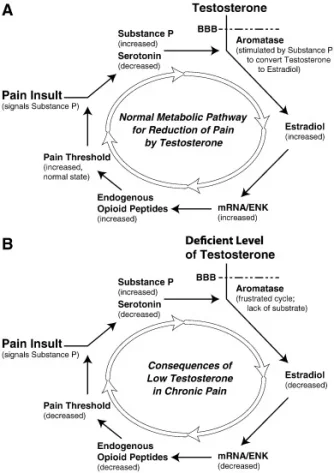Nelson Vergel
Founder, ExcelMale.com
A novel use for testosterone to treat central sensitization of chronic pain in fibromyalgia patients
Highlights
•Testosterone is effective therapy for fibromyalgia.•Low/deficient testosterone levels are linked to a high risk for chronic pain states.•Novel mechanisms by which testosterone is likely to down-modulate pain signals•Mechanisms involving testosterone are linked to central sensitization.
Abstract
Fibromyalgia is a diffuse chronic pain condition that occurs predominantly in women and may be under-reported in men. Symptoms include a loss of feeling of well-being and generalized widespread flu-like muscle aches and pain that fail to resolve due to central sensitization of nociceptive neurons. It has commonalities with a myriad of other chronic pain conditions which include PTSD, “Gulf War Syndrome”, and various stress-induced conditions caused, for example, by viral infection, emotional or physical stress, trauma, combat, accident or surgery. It is not understood why some individuals are susceptible to this condition and others are not. White et al., elsewhere in this issue, present a clinical feasibility study designed to test the hypothesis that 1) low or deficient testosterone serum levels are linked to a high risk for an inflamed nociceptive nervous system and resultant chronic pain states, and 2) a testosterone transdermal gel applied once a day by fibromyalgia patients can be an effective therapeutic against chronic pain. Here, a short profile of fibromyalgia is provided along with a brief summary of best practices currently recommended by clinical specialists. The link between testosterone and pain is then discussed, with an overview of scientific studies that lay the foundation for testosterone as a possible important additional therapeutic that has the potential to be safely administered and effective but also avoid the adverse effects of other therapeutics. Finally, novel mechanisms by which testosterone therapy is likely to down-modulate pain signaling are proposed.
______________________________
This diagram shows the hypothesis that aromatization to estradiol is the main factor in pain control.

Hypothesized signaling pathway for testosterone in relation to nociception in the CNS.A. In normal individuals, a painful/stressful stimulus up-regulates Substance P in the nociceptive relay neurons and serotonin levels drop, consistent with a loss of feeling of well-being [64]. Substance P has been found to stimulate aromatase [58], which would catalyze the conversion of testosterone to estradiol within the CNS, with subsequent upregulation of opiates and consequent dampening of pain. B. In fibromyalgia patients, deficient levels of testosterone are predicted to result in a “frustrated” cycle (due to lack of substrate) in which conversion of testosterone to estradiol is inadequate for induction of opiate-mediated dampening of nociceptive signals, resulting in abnormal chronic, diffuse, widespread pain. Estradiol, refers to 17-beta estradiol. See text for details and other hypothesized testosterone-based mechanisms.
Highlights
•Testosterone is effective therapy for fibromyalgia.•Low/deficient testosterone levels are linked to a high risk for chronic pain states.•Novel mechanisms by which testosterone is likely to down-modulate pain signals•Mechanisms involving testosterone are linked to central sensitization.
Abstract
Fibromyalgia is a diffuse chronic pain condition that occurs predominantly in women and may be under-reported in men. Symptoms include a loss of feeling of well-being and generalized widespread flu-like muscle aches and pain that fail to resolve due to central sensitization of nociceptive neurons. It has commonalities with a myriad of other chronic pain conditions which include PTSD, “Gulf War Syndrome”, and various stress-induced conditions caused, for example, by viral infection, emotional or physical stress, trauma, combat, accident or surgery. It is not understood why some individuals are susceptible to this condition and others are not. White et al., elsewhere in this issue, present a clinical feasibility study designed to test the hypothesis that 1) low or deficient testosterone serum levels are linked to a high risk for an inflamed nociceptive nervous system and resultant chronic pain states, and 2) a testosterone transdermal gel applied once a day by fibromyalgia patients can be an effective therapeutic against chronic pain. Here, a short profile of fibromyalgia is provided along with a brief summary of best practices currently recommended by clinical specialists. The link between testosterone and pain is then discussed, with an overview of scientific studies that lay the foundation for testosterone as a possible important additional therapeutic that has the potential to be safely administered and effective but also avoid the adverse effects of other therapeutics. Finally, novel mechanisms by which testosterone therapy is likely to down-modulate pain signaling are proposed.
______________________________
This diagram shows the hypothesis that aromatization to estradiol is the main factor in pain control.

Hypothesized signaling pathway for testosterone in relation to nociception in the CNS.A. In normal individuals, a painful/stressful stimulus up-regulates Substance P in the nociceptive relay neurons and serotonin levels drop, consistent with a loss of feeling of well-being [64]. Substance P has been found to stimulate aromatase [58], which would catalyze the conversion of testosterone to estradiol within the CNS, with subsequent upregulation of opiates and consequent dampening of pain. B. In fibromyalgia patients, deficient levels of testosterone are predicted to result in a “frustrated” cycle (due to lack of substrate) in which conversion of testosterone to estradiol is inadequate for induction of opiate-mediated dampening of nociceptive signals, resulting in abnormal chronic, diffuse, widespread pain. Estradiol, refers to 17-beta estradiol. See text for details and other hypothesized testosterone-based mechanisms.












